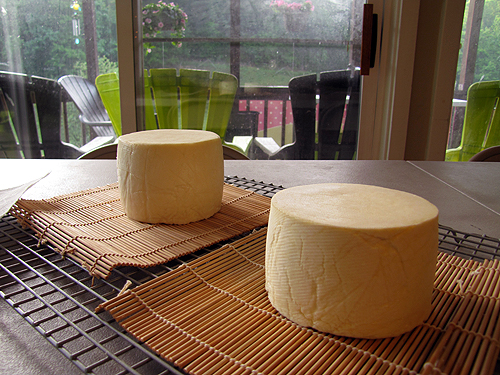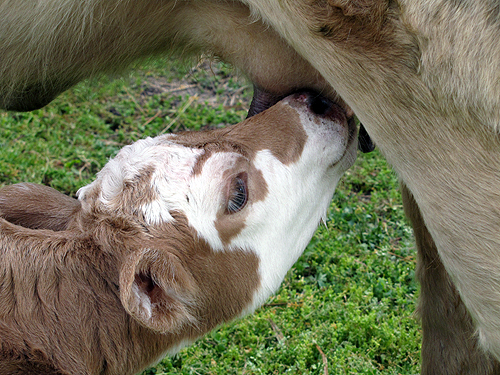
That’s cow’s milk Gouda on the right, goat’s milk Gouda on the left.
As I often tell people at workshops, cow milk is not goat milk, and goat milk is not cow milk. They’re the same but different. People who are lactose intolerant can often consume goat milk because it’s lower in lactose than cow’s milk. Also, goat milk doesn’t contain alpha S1 casein protein, which is an allergen for some people. Both the lower lactose and the missing allergen make goat milk more digestible for many people. But the differences don’t stop there. Goat’s milk is whiter, for one thing, because goats don’t process beta carotene, and it’s also naturally homogenized. Cow’s milk has larger fat globules than goat’s milk, allowing the fatty cream to separate, while the the smaller globules in goat’s milk allows it to stay homogenized. (Cow’s milk is homogenized by forcing the milk through a machine that breaks up those big fat globules.)
But it’s also all milk. Just milk. Goat milk isn’t weird or nasty, and it doesn’t taste bad. In fact, fresh goat milk is delicious and difficult to discern from cow milk if you aren’t very familiar with it. Goat milk only gets “goaty” if it’s not fresh or, often, if the nannies are running with the buck full-time. Compressed (cheese is basically compressed milk), flavor comes out, but again, if the cheese is fresh, it’s a good taste not a bad one–in fact, it’s awesome. (It’s so awesome, they sell lipase powder, which is a flavor-inducing enzyme, to replicate that deliciousness in cow’s milk for certain cheeses.) The characteristic, natural yet mild, flavor comes from the capric, caproic, and caprylic fatty acids that are present in goat milk.
You can make any cheese recipe with goat milk in place of cow milk, but the differences do come back into play. Goat milk contains more essential fatty acids (including also linoleic and arachidonic acids) than cow’s milk. This contributes to its easier digestibility, but it contributes to making goat milk a little trickier in setting a curd. In recipes where citric acid is used, the citric acid has to be reduced to account for goat milk’s natural higher acidity. (For example, in fresh mozzarella, I use half the citric acid when making it with goat milk as I do when making it with cow milk.) Goat milk also has a smaller and softer curd, and sometimes takes more time to set a curd. (I routinely add calcium chloride when making any goat cheese to strengthen the curd.) But the results are delicious, and worth the extra trouble.

My two Goudas, hanging out for a few days in a ripening box. (The damp paper towel is there to add humidity to the environment. I air-dried them for a few days, then put them in the ripening box with a lid. Next they’ll be waxed.)
Can’t wait to try them in a few months–and see which I like best!





